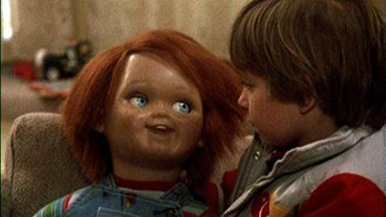|
|
The Number One Movie in America: Child's PlayBy Sean CollierOctober 26, 2019
For starters: The premise totally works. Not necessarily the origin of the doll — a sinister criminal uses a voodoo spell to transfer his soul into the toy’s frame as he bleeds out, an inciting incident on which your mileage may vary — but the basic setup of the scares. Someone — first adorable lad Andy (Alex Vincent), then his mother (Catherine Hicks) and finally a stalwart detective (Chris Sarandon) — tries to convince the world that an adorable doll is secretly a murderer. Everyone, naturally, reacts with skepticism. Then the doll kills them. Simple! Effective! “Child’s Play” also succeeds by taking a big cue from “Jaws.” We don’t see Chucky move — not in his murderous, full-bodied way, anyway — for more than half the film. Before then, it’s the sound of footsteps, a character peering at an off-screen threat or maybe a hand. When the doll begins not just talking — with the excellent, near-iconic voice of Brad Dourif in his mouth — but sneering, snarling and stabbing, it’s an excellent reveal. The biggest flaw in “Child’s Play” is the stereotypical use of an out-of-place shaman figure to give the voodoo backstory some momentum. Behind that, though, is an ending that sees Andy and company forced to kill Chucky what seems like a dozen times. Even then, it is telegraphed that the doll — or the spirit, anyway — is not yet fully vanquished. It’s an unnecessary complicated ending and tag on what4 should’ve been a simple, standalone chiller. Had “Child’s Play” been a one-and-done affair, it would’ve been a minor hit in a big year from horror. The returns diminished and diminished hard as Chucky became a mascot, unfortunately, but it was inevitable. What wisecracking ’80s horror villain didn’t get beaten into the ground? Metaphorically. Also, literally. “Child’s Play” is the subject of the latest episode of The Number One Movie in America, a look back at past box-office champions. Each episode’s film is drawn at random from a list of every number-one movie since 1982. Please listen and subscribe! Next time: Four franchises, all adapted from young-adult book series, have split their final chapter into two parts. Which Part 1 is the most successful? Nope - it's not Harry Potter..
[ View other Number One Movie in America articles ]
[ View other columns by Sean Collier ]
[ Email this column ]
|

|
|
|

|
Friday, November 1, 2024
© 2024 Box Office Prophets, a division of One Of Us, Inc.


